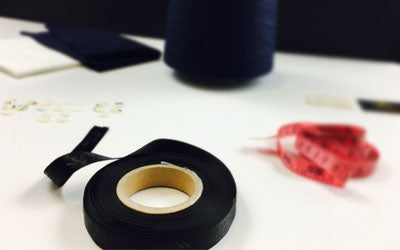BELTS STYLE GUIDE
Historically belts were used for mainly utilitarian purpose and most men would just own two belts in their wardrobes – one black and one brown for all their dressing up needs. Now people have realized the real potential of belts and they are more often used as a fashion accessory or even used to make an individual statement. The right belt can add the perfect finishing touch to any formal attire or casual look. It is one of those accessories that if bought with quality consideration, can be very durable and should not have to be replaced for a very long time. With a wide variety of belts and a huge influx of belt styling advice available, it often becomes difficult for men to grasp the essential information about belts. Whether it’s a simple casual look or refined formal attire, our guide’s got you covered! Read on to get the basics for buying, caring and styling with your belts all in one place.
TIPS ON BUYING THE RIGHT BELT
BUY THE RIGHT SIZE
The first step in buying the right belt is to figure out your belt size so your belt does not crease or stretch unnecessarily. A good rule of thumb is to buy a belt two sizes bigger than your pant size. If your pant waist size is 34” then you should try 36” size belt. Ideally you should be able to wrap the belt around your widest mid-section using the third (or middle) hole comfortably and thread the belt through the first loop. You should not have to hold your breath or stretch the belt to fasten it. Ensure you go for belts that are not overly long and certainly not too short since creasing, sagging and stretching will damage your belt.

CONSIDERATIONS FOR BUYING A FORMAL BELT
Formal belts are the one you’ll wear with tailored trousers and suits, therefore these should be completely understated. Some guidelines for buying a good formal belt are:
- As a starter make sure you have a leather belt in black, brown or tan colour matching with your formal dress shoes.
- Formal belts are narrower and usually will have a width between 1” - 1 3/8".
- Go for a shinier leather material for more formality. The strap should be plain or can have a subtle pattern, such as a fine weave or leather grain but it should not be very eye catchy so as to dominate the overall formal look.
- The buckle should be classic minimalist, polished in gold or silver, and single pronged.
CONSIDERATIONS FOR BUYING A CASUAL BELT
- As a starter buy one woven canvas belt with the same colour tone as your favourite sneakers colour.
- The belt's width can vary between 1 3/8" and 2".
- Buckles in casual belts can have a variety of shapes round, square or flat, small or large, matte or polished. The bigger the buckle the more casual the belt.
- Buckle can be single or double pronged.
- Casual belts can have varied materials from woven canvas belts to fabric belts to braided and elasticated belts.
TIPS ON STYLING YOUR BELTS
TAPPING THE VISUAL EFFECT POTENTIAL
Belts appear as a mid-sectioning line cutting the body in two halves. Keeping this visual effect in mind, men can control and use this to their advantage how belts make them look.
Taller men should wear bright coloured belts or with detailed styles or texture to bring the focus on the dividing line, making them appear shorter.
Shorter men wanting to look taller, should match their belt colour with either their shirt or trouser colour so that the dividing line can be concealed seamlessly giving an illusion of height.
BELTS AND TROUSERS SHOULD MATCH FORMALITY
As a generic rule narrow belts go with dress pants, chinos, dark jeans and trouser shorts; wider belts go well with lighter denims, cargo pants and cargo shorts.
MATCH YOUR BELT COLOUR WITH YOUR SHOES
Simply match the colour of your belt to your shoes. Brown belt goes with brown shoes, blue with blue, black with black and so on. There are however few exceptions e.g. when you are wearing white shoes or really bright coloured shoes e.g. burgundy or green. On such instances pair your shoes with a neutral belt – black or brown.
For a dressier look, it is preferred to first choose your shoes with the suit and then match the shoes with a corresponding belt since matching the shoes to the suit is more important that matching shoes with belt.
BELT MATERIAL SHOULD MATCH THE SHOE MATERIAL
Match the belt material with the shoe material. Shiny leather shoes call for formal shiny belt, canvas shoes call for woven canvas belt, sneakers call for fabric belts and so on.
BUY YOUR BELTS WITH CORRESPONDING SHOES
An ideal solution for ensuring a perfect match between belts and shoes is to buy them together at the same time. This will guarantee the belt colour, material and buckle polish is coordinated with your shoes every time.
MATCH YOUR BUCKLE TO YOUR ACCESSORIES
Normally all belt buckles either have a gold finish or a silver finish. There is no strict rule concerning the buckle colour, you can choose either silver or gold as per your preference. But if you are going to wear any metal accessories with your outfit e.g. cufflinks, tie pin, watch, shoe buckle etc. then you need to coordinate their colour with the buckle polish.
SUMMER BELTS
Summer season calls for a wardrobe change, everything gets more casual and lightened up so this is the perfect time to bring out your colourful woven canvas and fabric belts. The key is to embed it in your outfit to bring a burst of colour and some texture for a peppy casual look.
Woven and braided belts bring texture to the outfit and can be paired equally with lighter fabrics or even with denim. Fabric belts bring colour and if used properly they can really bring out your personal style. Pair your fabric belts with light coloured bottoms like white, beige or khaki to really showcase them. A safe bet for wearing brightly coloured belts is to make the rest of the outfit a little subdue. If your shirt is patterned then use a solid coloured belt, or if your belt has a pattern then pair it with a neutral coloured plain shirt.
NEVER WEAR BELT WITH A SUSPENDER
Suspenders and belts have the same purpose, holding your trousers in place. So use only one at a time!
PICK ONE STATEMENT: THE BELT OR THE SHOES
For casual wear, you can make your own fashion statement – but be sure not to have conflicting statements! Either choose your belt as a statement or your shoes. If one is the statement and prominent then the rest of your outfit needs to be diluted and subdued.
TIPS ON CARING FOR YOUR BELTS
STORE AND HANG YOUR BELTS PROPERLY
Imperative for increasing lifetime of belts is to store them or hang them properly. Ideally belts should be hanged naturally on a belt hanger or on wall hooks. Alternatively you can roll them and store them in shoe boxes.
ALWAYS REMOVE YOUR BELT FROM THE TROUSER
Always remember to remove your belt from your trousers, since leaving it in will weaken both the belt and the belt loops.
KEEP BELTS DRY
Belts get damaged when they get wet and we try to accelerate the drying process. So keep your belt dry and if it gets wet then let it dry naturally.
USE CONDITIONER
To increase lifespan for leather belts or leather parts of a belt it is a good idea to use conditioner on them which restores the leather’s natural moisture.
KEEP YOUR BELTS ROTATING
On an average a belt wears out in 9-12 months of daily use. To increase lifespan of your belt keep more than one in rotation at any given time. This gives each belt time to dry out and also the wear and tear of the belt is reduced.
So there it is – all essential information that hopefully will assist you in buying and styling your next new belt!

